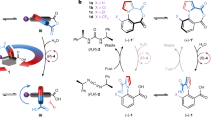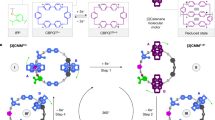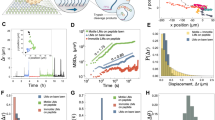Abstract
Biological systems mainly utilize chemical energy to fuel autonomous molecular motors, enabling the system to be driven out of equilibrium1. Taking inspiration from rotary motors such as the bacterial flagellar motor2 and adenosine triphosphate synthase3, and building on the success of light-powered unidirectional rotary molecular motors4,5,6, scientists have pursued the design of synthetic molecular motors solely driven by chemical energy7,8,9,10,11,12,13. However, designing artificial rotary molecular motors operating autonomously using a chemical fuel and simultaneously featuring the intrinsic structural design elements to allow full 360° unidirectional rotary motion like adenosine triphosphate synthase remains challenging. Here we show that a homochiral biaryl Motor-3, with three distinct stereochemical elements, is a rotary motor that undergoes repetitive and unidirectional 360° rotation of the two aryl groups around a single-bond axle driven by a chemical fuel. It undergoes sequential ester cyclization, helix inversion and ring opening, and up to 99% unidirectionality is realized over the autonomous rotary cycle. The molecular rotary motor can be operated in two modes: synchronized motion with pulses of a chemical fuel and acid–base oscillations; and autonomous motion in the presence of a chemical fuel under slightly basic aqueous conditions. This rotary motor design with intrinsic control over the direction of rotation, simple chemical fuelling for autonomous motion and near-perfect unidirectionality illustrates the potential for future generations of multicomponent machines to perform mechanical functions.
This is a preview of subscription content, access via your institution
Access options
Access Nature and 54 other Nature Portfolio journals
Get Nature+, our best-value online-access subscription
$29.99 / 30 days
cancel any time
Subscribe to this journal
Receive 51 print issues and online access
$199.00 per year
only $3.90 per issue
Buy this article
- Purchase on Springer Link
- Instant access to full article PDF
Prices may be subject to local taxes which are calculated during checkout




Similar content being viewed by others
Data availability
Details on the procedures, characterization and references, including spectra of new compounds and compounds made using the reported method, are available in Supplementary Information. Crystallographic data for (S,S')-Motor-1-Me, (R,S')-3-Me, Motor-1-K, Motor-1-T-MOM and Motor-Br-Me can be obtained free of charge from www.ccdc.cam.ac.uk under CCDC deposition numbers 2170186, 2170187, 2170188, 2170189 and 2170190.
Change history
22 December 2022
Editor’s Note: Readers are alerted that the authors have discovered that the motion of molecular motor reported in this paper appears to be very sensitive to pH change, which occurs during fuel consumption. A further editorial response will follow the based on the investigation of this issue.
10 July 2023
This article has been retracted. Please see the Retraction Notice for more detail: https://doi.org/10.1038/s41586-023-06380-2
References
Saper, G. & Hess, H. Synthetic systems powered by biological molecular motors. Chem. Rev. 120, 288–309 (2020).
Sowa, Y. et al. Direct observation of steps in rotation of the bacterial flagellar motor. Nature 437, 916–919 (2005).
Boyer, P. D. The ATP synthase—a splendid molecular machine. Annu. Rev. Biochem. 66, 717–749 (1997).
Wang, J. & Feringa, B. L. Dynamic control of chiral space in a catalytic asymmetric reaction using a molecular motor. Science 331, 1429–1432 (2011).
Roke, D., Wezenberg, S. J. & Feringa, B. L. Molecular rotary motors: unidirectional motion around double bonds. Proc. Natl Acad. Sci. USA 115, 9423–9431 (2018).
Browne, W. R. & Feringa, B. L. Making molecular machines work. Nat. Nanotechnol. 1, 25–35 (2006).
Kelly, T. R. et al. Progress toward a rationally designed, chemically powered rotary molecular motor. J. Am. Chem. Soc. 129, 376–386 (2007).
Anelli, P. L., Spencer, N. & Stoddart, J. F. A molecular shuttle. J. Am. Chem. Soc. 113, 5131–5133 (1991).
Badjić, J. D., Balzani, V., Credi, A., Silvi, S. & Stoddart, J. F. A molecular elevator. Science 303, 1845–1849 (2004).
Cárdenas, D. J., Livoreil, A. & Sauvage, J.-P. Redox control of the ring-gliding motion in a Cu-complexed catenane: a process involving three distinct geometries. J. Am. Chem. Soc. 118, 11980–11981 (1996).
Jiménez, M. C., Dietrich-Buchecker, C. & Sauvage, J.-P. Towards synthetic molecular muscles: contraction and stretching of a linear rotaxane dimer. Angew. Chem. Int. Ed. 39, 3284–3287 (2000).
Silvi, S., Venturi, M. & Credi, A. Artificial molecular shuttles: from concepts to devices. J. Mater. Chem. 19, 2279–2294 (2009).
Stevens, A. M. & Richards, C. J. A metallocene molecular gear. Tetrahedron Lett. 38, 7805–7808 (1997).
Geeves, M. A. & Holmes, K. C. Structural mechanism of muscle contraction. Annu. Rev. Biophys. 68, 687–728 (1999).
Hua, W., Chung, J. & Gelles, J. Distinguishing inchworm and hand-over-hand processive kinesin movement by neck rotation measurements. Science 295, 844–848 (2002).
Vale, R. D. The molecular motor toolbox for intracellular transport. Cell 112, 467–480 (2003).
Erbas-Cakmak, S., Leigh, D. A., McTernan, C. T. & Nussbaumer, A. L. Artificial molecular machines. Chem. Rev. 115, 10081–10206 (2015).
van Dijk, L. et al. Molecular machines for catalysis. Nat. Rev. Chem. 2, 0117 (2018).
Aprahamian, I. The future of molecular machines. ACS Cent. Sci. 6, 347–358 (2020).
Astumian, R. D. Kinetic asymmetry allows macromolecular catalysts to drive an information ratchet. Nat. Commun. 10, 3837 (2019).
Koumura, N., Zijlstra, R. W. J., van Delden, R. A., Harada, N. & Feringa, B. L. Light-driven monodirectional molecular rotor. Nature 401, 152–155 (1999).
Kelly, T. R., De Silva, H. & Silva, R. A. Unidirectional rotary motion in a molecular system. Nature 401, 150–152 (1999).
Greb, L. & Lehn, J.-M. Light-driven molecular motors: imines as four-step or two-step unidirectional rotors. J. Am. Chem. Soc. 136, 13114–13117 (2014).
Erbas-Cakmak, S. et al. Rotary and linear molecular motors driven by pulses of a chemical fuel. Science 358, 340–343 (2017).
Bach, N. N., Josef, V., Maid, H. & Dube, H. Active mechanical threading by a molecular motor. Angew. Chem. Int. Ed. 61, e202201882 (2022).
Fletcher, S. P., Dumur, F., Pollard, M. M. & Feringa, B. L. A reversible, unidirectional molecular rotary motor driven by chemical energy. Science 310, 80–82 (2005).
Collins, B. S. L., Kistemaker, J. C. M., Otten, E. & Feringa, B. L. A chemically powered unidirectional rotary molecular motor based on a palladium redox cycle. Nat. Chem. 8, 860–866 (2016).
Zhang, Y. et al. A chemically driven rotary molecular motor based on reversible lactone formation with perfect unidirectionality. Chem 6, 2420–2429 (2020).
Corra, S. et al. Artificial supramolecular pumps powered by light. Chem. Eur. J. 27, 11076–11083 (2021).
Guentner, M. et al. Sunlight-powered kHz rotation of a hemithioindigo-based molecular motor. Nat. Commun. 6, 8406 (2015).
Koumura, N., Geertsema, E. M., van Gelder, M. B., Meetsma, A. & Feringa, B. L. Second generation light-driven molecular motors. Unidirectional rotation controlled by a single stereogenic center with near-perfect photoequilibria and acceleration of the speed of rotation by structural modification. J. Am. Chem. Soc. 124, 5037–5051 (2002).
Lubbe, A. S. et al. Photoswitching of DNA hybridization using a molecular motor. J. Am. Chem. Soc. 140, 5069–5076 (2018).
Pooler, D. R. S., Lubbe, A. S., Crespi, S. & Feringa, B. L. Designing light-driven rotary molecular motors. Chem. Sci. 12, 14964–14986 (2021).
Štacko, P. et al. Locked synchronous rotor motion in a molecular motor. Science 356, 964–968 (2017).
Zhao, D., van Leeuwen, T., Cheng, J. & Feringa, B. L. Dynamic control of chirality and self-assembly of double-stranded helicates with light. Nat. Chem. 9, 250–256 (2016).
Wilson, M. R. et al. An autonomous chemically fuelled small-molecule motor. Nature 534, 235–240 (2016).
Borsley, S., Kreidt, E., Leigh, D. A. & Roberts, B. M. W. Autonomous fuelled directional rotation about a covalent single bond. Nature 604, 80–85 (2022).
Bringmann, G. et al. Atroposelective synthesis of axially chiral biaryl compounds. Angew. Chem. Int. Ed. 44, 5384–5427 (2005).
Seeman, J. I. The Curtin–Hammett principle and the Winstein–Holness equation: new definition and recent extensions to classical concepts. J. Chem. Educ. 63, 42–48 (1986).
Koumura, N., Geertsema, E. M., Meetsma, A. & Feringa, B. L. Light-driven molecular rotor: unidirectional rotation controlled by a single stereogenic center. J. Am. Chem. Soc. 122, 12005–12006 (2000).
Aikawa, K., Miyazaki, Y. & Mikami, K. Stable axial chirality in metal complexes bearing 4,4′-substituted BIPHEPs: application to catalytic asymmetric carbon–carbon bond-forming reactions. Bull. Chem. Soc. Jpn 85, 201–208 (2012).
Mori, K. et al. Enantioselective synthesis of multisubstituted biaryl skeleton by chiral phosphoric acid catalyzed desymmetrization/kinetic resolution sequence. J. Am. Chem. Soc. 135, 3964–3970 (2013).
Acknowledgements
We are grateful for the support of this work by the National Natural Science Foundation of China (21971267), the Fundamental Research Funds for the Central Universities, Sun Yat-sen University (22lgqb34) and the programme for Guangdong Introducing Innovative and Entrepreneurial Teams (2017ZT07C069). B.L.F. acknowledges financial support from the European Research Council (ERC; advanced grant number 694345 to B.L.F.) and the Dutch Ministry of Education, Culture and Science (Gravitation programme number 024.001.035).
Author information
Authors and Affiliations
Contributions
D.Z., K.M., Y.Z. and B.L.F. conceived the project. K.M., Y.Z., Z.D. and X.M. carried out the synthesis and characterized the motion of the molecular motor. K.M. and Y.Y. performed all XRD measurements and structural analysis. D.Z. and B.L.F. guided the research; K.M., Y.Z., D.Z. and B.L.F wrote the manuscript. All authors discussed the results and commented on the manuscript.
Corresponding authors
Ethics declarations
Competing interests
The authors declare no competing interests.
Peer review
Peer review information
Nature thanks He Tian and the other, anonymous, reviewer(s) for their contribution to the peer review of this work.
Additional information
Publisher’s note Springer Nature remains neutral with regard to jurisdictional claims in published maps and institutional affiliations.
This article has been retracted. Please see the retraction notice for more detail: https://doi.org/10.1038/s41586-023-06380-2
Extended data figures and tables
Extended Data Fig. 1 Single-crystal structures of 3-Me, Motor-1-Me, Motor-1-K and MOM-derived thermodynamic product (Motor-1-T-MOM).
(a) The absolute configuration of molecular motors was unambiguously established by single-crystal X-ray diffraction as well (Here, the S or R denotes the configuration of the chiral centre at the α position of carboxylic acid group, S’ or R’ denotes the configuration of the chiral centre of the benzyl position). Single crystal X-ray diffraction experiments of the corresponding methyl esters 3-Me and Motor-1-Me were performed to gain insight into the relationship between configurations and cyclization selectivity. The results indicated the orientation of the carboxylic group is key to realize high selectivity of cyclization. Viewed along the biaryl C–C bond (the axle of rotation), the carboxylic group in (S,S’)-syn-isomer−1 favours bridge formation with the hydroxyl group on the right of the stator aryl to generate exclusively the kinetic isomer. However, the methyl group at the α-position of the carboxylic group in (R,S’)-anti-isomer 3 blocked the carboxylic group from reacting with hydroxyl group on the right side of the stator aryl and therefore cyclized with the left hydroxyl group to give dominantly a thermodynamic isomer. (b) Single-crystal X-Ray diffraction of Motor-1-K and MOM-protected Motor-1-T-MOM confirmed that the rotational direction of Motor-1 was clockwise. It is interesting to note the favoured tub-shaped conformation of the eight-membered ring in Motor-1-T and Motor-1-K. In Motor-1-K, the methyl group adopts a pseudoaxial orientation while the methoxy group is located in a pseudoequatorial position. However, in the case of Motor-1-T, the methoxy group is in a pseudoaxial orientation and the methyl group adopts a pseudoequatorial position. The eight-membered ring flipping can be explained by Winstein–Holness A value which is used to describe the conformational preference of an equatorial compared to an axial substituent in a substituted cyclohexane. As the A value of a methyl group (1.7 kcal/mol) is larger than the A value of a methoxy group (0.6 kcal/mol), the methyl group has a strong tendency for the equatorial position which also drives the helix inversion of the biaryl and the conversion of Motor-1-K to Motor-1-T (P to M).
Extended Data Fig. 2 1H NMR spectra of three stations of Motor-1.
1H NMR spectra of three states (Motor-1, Motor-1-K, Motor-1-T) during the 180° unidirectional rotation. In the first step, Motor-1 was cyclized to give a high-energy isomer Motor-1-K in the presence of the fuel EDC in DCM at 0 °C and this is the only energy input step in the half cycle of rotation. Motor-1-K unstable isomer then underwent an energetic downhill helix inversion to yield the Motor-1-T with a final ratio of T/K = 4/1. Analysis of the kinetic data provided the Gibbs free energy of activation Δ‡G° = 103.6 kJ/mol (t1/2 = 45 h at 298.15 K) (Supplementary Fig. 9).
Supplementary information
Supplementary Information
This Supplementary Information file contains 17 sections and includes 40 figures and 5 tables.
Rights and permissions
Springer Nature or its licensor (e.g. a society or other partner) holds exclusive rights to this article under a publishing agreement with the author(s) or other rightsholder(s); author self-archiving of the accepted manuscript version of this article is solely governed by the terms of such publishing agreement and applicable law.
About this article
Cite this article
Mo, K., Zhang, Y., Dong, Z. et al. RETRACTED ARTICLE: Intrinsically unidirectional chemically fuelled rotary molecular motors. Nature 609, 293–298 (2022). https://doi.org/10.1038/s41586-022-05033-0
Received:
Accepted:
Published:
Issue Date:
DOI: https://doi.org/10.1038/s41586-022-05033-0
This article is cited by
-
A catenane that is topologically achiral despite being composed of oriented rings
Nature Chemistry (2023)
Comments
By submitting a comment you agree to abide by our Terms and Community Guidelines. If you find something abusive or that does not comply with our terms or guidelines please flag it as inappropriate.



